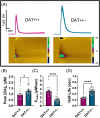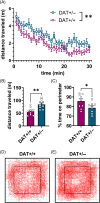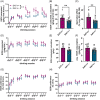Patterns of ethanol intake in male rats with partial dopamine transporter deficiency
- PMID: 37461188
- PMCID: PMC10733570
- DOI: 10.1111/gbb.12847
Patterns of ethanol intake in male rats with partial dopamine transporter deficiency
Abstract
Mesolimbic dopamine signaling plays a major role in alcohol and substance use disorders as well as comorbidities such as anxiety and depression. Growing evidence suggests that alcohol drinking is modulated by the function of the dopamine transporter (DAT), which tightly regulates extracellular dopamine concentrations. Adult male rats on a Wistar Han background (DAT+/+) and rats with a partial DAT deletion (DAT+/-) were used in this study. First, using fast-scan cyclic voltammetry in brain slices containing the nucleus accumbens core from ethanol-naïve subjects, we measured greater evoked dopamine concentrations and slower dopamine reuptake in DAT+/- rats, consistent with increased dopamine signaling. Next, we measured ethanol drinking using the intermittent access two-bottle choice paradigm (20% v/v ethanol vs. water) across 5 weeks. DAT+/- rats voluntarily consumed less ethanol during its initial availability (the first 30 min), especially after longer periods of deprivation. In addition, DAT+/- males consumed less ethanol that was adulterated with the bitter tastant quinine. These findings suggest that partial DAT blockade and concomitant increase in brain dopamine levels has potential to reduce drinking and ameliorate alcohol use disorder (AUD).
Keywords: Wistar; alcohol use disorder; binge; dopamine; dopamine transporter; drinking; ethanol; fast-scan cyclic voltammetry; hypodopaminergia; intermittent access; locomotor activity; novelty; nucleus accumbens; quinine; reuptake.
© 2023 The Authors. Genes, Brain and Behavior published by International Behavioural and Neural Genetics Society and John Wiley & Sons Ltd.
Figures






Similar articles
-
No effect of sex on ethanol intake and preference after dopamine transporter (DAT) knockdown in adult mice.Psychopharmacology (Berl). 2019 Apr;236(4):1349-1365. doi: 10.1007/s00213-018-5144-9. Epub 2018 Dec 12. Psychopharmacology (Berl). 2019. PMID: 30539268
-
Decreased ethanol preference and consumption in dopamine transporter female knock-out mice.Alcohol Clin Exp Res. 2002 Jun;26(6):758-64. Alcohol Clin Exp Res. 2002. PMID: 12068242
-
Supersensitive Kappa Opioid Receptors Promotes Ethanol Withdrawal-Related Behaviors and Reduce Dopamine Signaling in the Nucleus Accumbens.Int J Neuropsychopharmacol. 2016 Apr 29;19(5):pyv127. doi: 10.1093/ijnp/pyv127. Print 2016 May. Int J Neuropsychopharmacol. 2016. PMID: 26625893 Free PMC article.
-
Chronic ethanol consumption increases dopamine uptake in the nucleus accumbens of high alcohol drinking rats.Alcohol. 2006 Oct;40(2):103-9. doi: 10.1016/j.alcohol.2006.10.003. Alcohol. 2006. PMID: 17307646 Free PMC article.
-
Alcohol consumption alters dopamine transporter sites in Wistar-Kyoto rat brain.Brain Res. 2006 Feb 16;1073-1074:175-82. doi: 10.1016/j.brainres.2005.12.009. Epub 2006 Feb 2. Brain Res. 2006. PMID: 16457790
Cited by
-
Inhibition of the Sodium-Calcium Exchanger Reverse Mode Activity Reduces Alcohol Consumption in Rats.Int J Mol Sci. 2024 Apr 8;25(7):4132. doi: 10.3390/ijms25074132. Int J Mol Sci. 2024. PMID: 38612942 Free PMC article.
References
-
- CDC . Excessive alcohol use. September 21, 2020. Accessed July 27, 2021. https://www.cdc.gov/chronicdisease/resources/publications/factsheets/alc...
-
- NIAAA . Genetics of alcohol use disorder. Accessed July 27, 2021. https://www.niaaa.nih.gov/alcohols-effects-health/alcohol-use-disorder/g...
Publication types
MeSH terms
Substances
Grants and funding
LinkOut - more resources
Full Text Sources

